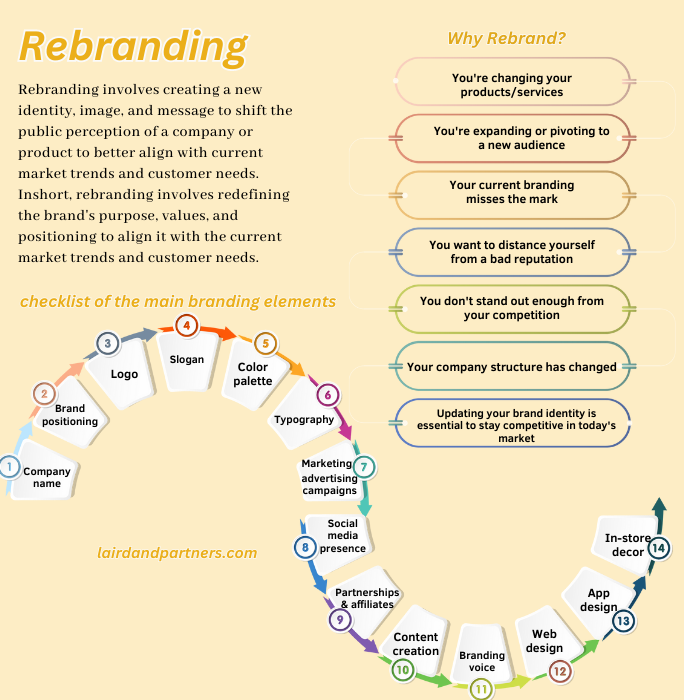Rebranding: A Strategic and Tactical Guide for Success
Rebranding involves creating a new identity, image, and message to shift the public perception of a company or product to better align with current market trends and customer needs.
Inshort, rebranding involves redefining the brand’s purpose, values, and positioning to align it with the current market trends and customer needs.

More Resources :
Three main types of rebranding
A subtle update to an existing brand that retains its core elements while modernizing certain aspects such as logo design or color palette.
A more significant change involving updates to multiple branding elements like messaging, visual identity, and marketing strategy.
A complete overhaul of all branding components resulting in a totally new look and feel for the company or product.
A successful rebrand requires careful planning and execution to ensure it resonates with your target audience while preserving your established reputation.
Laird & Partners is a fully-integrated creative marketing agency that specializes in working with brands who need to win with style. Hence, here we’ll explore why our past clients choose to undergo this transformational process along with giving tactical considerations for effective implementation!
The Importance of Relevance in Today’s Market

In today’s fast-paced business environment where consumer preferences can shift rapidly due to evolving trends or emerging competitors, maintaining relevance is crucial for long-term success. Companies must be able to adapt their offerings accordingly without losing sight of their unique value proposition. This often necessitates updating not only your products or services, but also changing their presentation through branding and marketing efforts.
Aligning with Your Target Audience
A key aspect of rebranding is ensuring your new identity aligns with the needs and preferences of your target audience. This requires a deep understanding of their demographics, psychographics, and behaviors in order to create an authentic connection that drives brand loyalty. Analyzing market data and trends can reveal valuable insights that can help guide rebranding strategies.
Maintaining Consistency Across Channels
When undertaking a rebrand, it’s essential to maintain consistency across all touchpoints where customers interact with your business – from digital platforms like social media and websites to physical spaces such as retail stores or event booths. This cohesive approach ensures a seamless transition for existing customers while attracting new ones by presenting a unified message that resonates on multiple levels.
To make a lasting impression in the marketplace, businesses must consider rebranding as an effective way to create a new image. By understanding why rebranding may be necessary, you can develop effective strategies to ensure success in your rebranding efforts.
Why Rebrand?
Rebranding is a significant decision for any business, as it involves revamping the company’s identity and image. But when is it time to rebrand? Here are some common reasons that may signal the need for a change:
If you’re shifting your focus or expanding your offerings, it’s essential to ensure that your branding aligns with these changes. A new brand identity can help communicate this evolution effectively.
As businesses grow, they often target different demographics or markets. Rebranding can be useful to create a captivating image that speaks to the new target demographic.
Sometimes, brands don’t accurately reflect their values and goals. This disconnect could lead customers to perceive them differently than intended. A well-executed rebranding strategy can bridge this gap by creating an accurate representation of what the company stands for.
Negative publicity or poor customer experiences might tarnish a brand’s reputation over time. Rebranding offers an opportunity for companies to start fresh and rebuild trust among consumers.
In today’s competitive market landscape, having unique positioning is crucial in attracting customers’ attention and setting yourself apart from competitors. Reevaluating your branding elements will enable you to create differentiation within your industry.
Mergers, acquisitions, or internal restructuring often necessitate a rebrand to reflect the new organizational structure and direction.
As time passes, branding trends evolve. A dated brand identity might signal that your company is out of touch with current market preferences. Updating your brand identity is essential to stay competitive in today’s market and ensure your company remains relevant.
Revamping is an imperative measure for guaranteeing a business’s long-term success, as it can invigorate its image and attract fresh customers.
Tactics To Successfully Rebrand Your Business
Rebranding necessitates a strategic and meticulous approach to guarantee prosperity. To help you keep track, here’s a checklist of the main branding elements you want to put under a microscope. How does your brand perform in each of the following areas?
- Company name:
Is your current company name still relevant and reflective of your business? If not, consider changing it to better align with your new direction.
- Brand positioning:
Assess how well your brand stands out from competitors and resonates with target audiences. A strong brand positioning will differentiate you from others in the market while communicating unique value propositions.
- Logo:
Your logo should be visually appealing, memorable, and representative of your brand’s identity. Evaluate whether it needs an update or complete redesign during rebranding efforts.
- Slogan:
A catchy slogan can make a lasting impression on customers – ensure yours effectively communicates what sets you apart from competitors.
- Color palette:
The colors used in branding materials have psychological effects on consumers; choose wisely based on desired emotions associated with products/services offered by the company (e.g., trustworthiness).
- Typography:
Fonts play an important role in conveying personality, tone, and style. Select fonts that complement other design elements while maintaining readability across various platforms.
- Marketing and advertising campaigns:
Analyze past campaigns’ effectiveness before launching new ones as part of the rebrand strategy; learn from successes and failures to improve future efforts.
- Social media presence:
Ensure your social media profiles are consistent with the new branding direction and effectively engage target audiences. Sprout Social offers helpful tips for building a cohesive online presence.
- Partnerships and affiliates:
Reevaluate existing partnerships to ensure they align with your rebranding goals, and consider forming new collaborations that support your brand’s growth.
- Content creation:
Create high-quality, engaging content that reflects the new brand identity and appeals to target audiences.
- Branding voice:
Your brand’s voice should be consistent across all channels of communication – from website copy to customer service interactions. Establish guidelines for tone, style, and language use during the rebranding process.
- Web design:
A well-designed website is crucial in today’s digital age; make sure it accurately represents your updated brand image while providing an excellent user experience.
Consider working with professional web designers like those at Laird & Partners.
- App design:
If you have a mobile app, update its design elements to match your new branding strategy – ensuring consistency across platforms.
- In-store decor:
For brick-and-mortar businesses, updating store interiors (signage, displays) can help reinforce the rebranded image in customers’ minds while providing a refreshed shopping experience.
By understanding the tactical considerations for rebranding, businesses can ensure that their new brand is well-positioned and positioned to succeed.
Tips for Successful Rebranding
Successful rebranding requires careful planning and execution to achieve desired results without damaging existing customer relationships. To ensure a smooth transition, consider the following tips:
Gather a team of experts in branding, marketing, design and other related disciplines from both within your organization and outside sources. This may include hiring an external creative marketing and branding agency, such as Laird and Partners, or assembling an internal team within your organization.
Analyze your current customers’ demographics, preferences, behaviors, and needs to better understand their expectations from your brand. Also research potential new audiences you want to reach through rebranding efforts.
Determine the desired outcome of rebranding initiatives (e.g., enlarged market penetration). Establish specific goals that are measurable (e.g., increase website traffic by 20% within six months). Also, create a timeline for implementing changes.
Evaluate how competitors position themselves in the market and identify opportunities where your brand can differentiate itself from them. Learn from both their successes and failures when crafting your own strategy.
Prioritize testing various elements of the proposed rebranded identity—such as logo designs or taglines—with focus groups or surveys before committing fully to any changes. This will help minimize risks associated with drastic alterations that might not resonate well with customers.
Utilize social media, email marketing, and other digital channels to communicate the new brand identity to your audience. Engage with customers through these platforms by sharing updates on the rebranding process and seeking their feedback.
Analyze data from various sources—such as Google Analytics or Salesforce Marketing Cloud—to evaluate whether your rebranding efforts have been successful in achieving set objectives. Use this information to make any necessary adjustments and refine strategies going forward.
Incorporating these tips into your rebranding strategy will help increase its chances of success while minimizing potential risks associated with such a significant undertaking. Remember that effective communication is crucial during this period; keep stakeholders informed about progress made towards goals so they can support changes being implemented across all aspects of your business operations.
How Rebranding Benefits Your Business ?
By rebranding, businesses can take advantage of numerous advantages such as increased visibility, improved customer loyalty and more.
A. Increased Visibility
One of the primary goals of a successful rebrand is to create a fresh image that captures attention and stands out from competitors. A well-executed rebrand can help increase brand visibility, making it easier for potential customers to discover your products or services.
B. Improved Customer Loyalty
Revising your organization’s communication and principles to more accurately reflect the wants and needs of your target demographic can help create stronger relationships with current customers, as well as attract new ones who share similar interests or views – resulting in greater customer loyalty. By doing so, you can foster stronger connections with existing customers while also attracting new ones who share similar interests or beliefs—ultimately leading to improved customer loyalty.
C. Higher Sales Revenue
D. Greater Recognition Among Target Audiences
By updating and refining your brand’s messaging, visuals, and overall identity, you can create a more memorable impression on potential customers. This increased recognition among target audiences can lead to greater trust and credibility, making it easier for them to choose your business over competitors when they’re ready to make a purchase.
E. Opportunities for Growth and Expansion into New Markets
A well-executed rebrand may open up new opportunities for growth by appealing to different demographics or expanding into previously untapped markets. For example, if your original branding was too niche or limited in scope, an updated image could attract a broader audience that helps fuel future expansion efforts.
Rebranding can offer a chance to strengthen visibility and familiarity with the brand, as well as develop an emotional bond with customers. However, rebranding can present some obstacles that need to be taken into account before deciding on any such action.
Challenges of Rebranding
Rebranding can be a difficult and intricate undertaking for organizations, necessitating the expenditure of considerable resources such as money and time to carry out effectively.
Potential Risks Associated with Rebranding
There is always a risk that customers may not respond positively to changes made during rebranding efforts which could lead to decreased sales or even damage the company’s reputation if not handled properly.
Customer Confusion:
A sudden change in branding might confuse existing customers who have become accustomed to your previous brand identity. This confusion can result in reduced customer loyalty and lost sales.
Negative Perception:
If the new branding fails to resonate with your target audience or is perceived negatively, it could harm your business’s image and credibility. It’s crucial to conduct thorough research before implementing any changes.
Ineffective Communication:
Poorly executed communication strategies during the rebranding process can leave stakeholders feeling uninformed or alienated, leading them away from embracing the new brand direction.
Budget Constraints:
The cost of rebranding can be substantial, especially for small businesses on tight budgets. Allocating sufficient funds for all aspects of the project is essential for success.
Rebrand Your Business Today!
If you’re looking to undertake a successful rebranding project for your business or brand, contact Laird&Partners today! Our team of specialists can help you devise a plan that meets your objectives and ensures uniformity throughout the entire rebranding journey.






